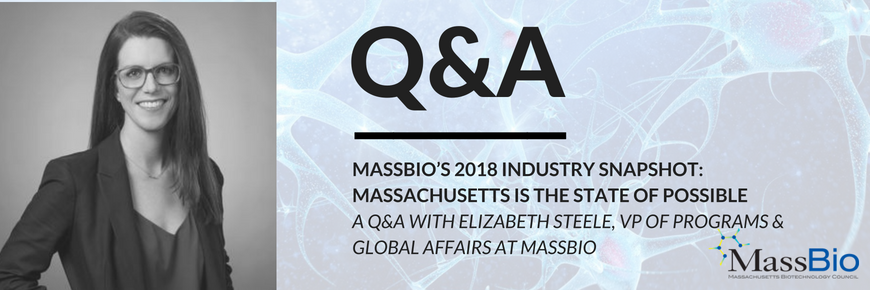
Last week, MassBio released its 2018 Industry Snapshot report, which shows that the Massachusetts biopharma industry continues to grow at an impressive rate, captured through investments, IPOs, job growth and more. Our Director of Communications, Jennifer Nason, sat down with Elizabeth Steele, VP of Programs & Global Affairs, to dig into the data to see what this means for our members, patients and the industry at large.
Jennifer: What are the biggest takeaways from this report?
Elizabeth: Massachusetts biopharmas dominated both the IPO market and venture capital investment in 2017, accounting for nearly half (48%) of all US-based biotech IPOs and 37% of all US biopharma VC dollars. VC investors poured $3.1 billion into these companies –the highest ever. When looking at the first half of 2018, it looks like we’re on track to beat 2017 records, with $2.7 billion already invested. Job growth has also remained strong, with consistent 4-5% increases in the last few years, and nearly 30% growth over the last decade. Our state continues to attract the greatest share of NIH funding per capita, with five of the top six NIH-funded independent hospitals. All in all, 2017 was an incredible year for our industry, and 2018 is on track to be even better.
Jennifer: That’s a lot of investment. Are you afraid we’re in a bubble?
Elizabeth: I do not believe we’re in a bubble because the money is following the science, and the science behind these companies is too strong for me to believe we’re headed for a downturn. We’re seeing a new wave of breakthrough therapies that treat the underlying cause of disease, not just the symptoms – people are even starting to use the word “cure” for some of them. Savvy investors want to be a part of this success. Savvy is an important word here – these are investors that understand the industry and the inherent risks involved. But they also recognize the potential rewards, and although every biotech will not make it to commercialization, for those that do, investors will get a good return on investment and can re-invest in the next startup and contribute to helping patients around the world.
Jennifer: What challenges does this growth present? How is MassBio addressing them?
Elizabeth: Sustained growth always comes with challenges, and I can think of two in particular that we’re focused on. One is workforce development. MassBioEd, our sister organization, is predicting nearly 12,000 new jobs by May 2023, and are looking to our high schools and local universities to fill them. Competition for talent is already at an all-time-high, so we need new workers coming into the industry, and that starts with our schools. MassBioEd is helping to get kids excited about career opportunities in the life sciences, along with making clear pathways from colleges and universities, including community colleges, to biopharma companies. The second is physical space and rent. Our industry is concentrated in the Cambridge/Boston area, but with that concentration comes high rents and little availability. That’s why we’re supporting growth in all corners of Massachusetts, helping towns and cities attract biopharma companies, and spreading out the wealth.